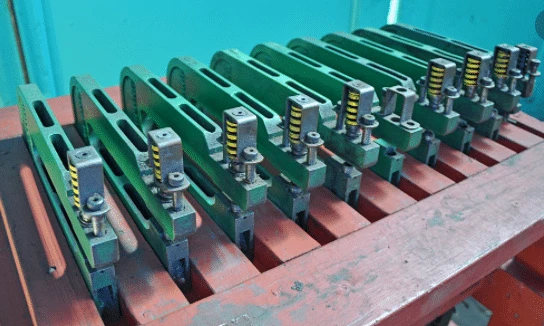C-frame punches are a commonly used type of hydraulic press. These punches get their name from the fact that the punch itself is shaped like the letter “C”, however the punch may be referred to by other names such as “gap-frame punch”.
Hydraulic C-frame punches are designed to take up less floor space than other metalworking machinery, while still providing great utility and minimal stroke deflection.

They have numerous benefits to offer, such as,
- Acquire minimal floor space
- 3-access points
- Easy to use
- Cost effective
Just like other hydraulic punches, C-frame punches are extremely versatile and can be used for many applications across several different industries.
Applications of Hydraulic C-Frame Punch
- Assembly and bending
These punches are widely used for the purpose of efficient assembly and bending owing to their C-frame.
Assembly: Fastening two or more parts together with a hydraulic assembly punch.
Bending: Straining material, usually flat sheet or strip metal, by moving it around a straight axis and applying stress. The bend is permanently set after removal of the applied stress.
- Work as a crimping tool
Crimping can be an effective way to conjoin two pieces of metal, such as attaching a connector to the end of a cable, by re-shaping one or both to hold them together.
An assembly technique that uses a custom assembly press and appropriate tool to fold and flatten material so that two pieces are securely fastened together by pinching action. This technique is commonly used to join sheet metal parts.
- Piercing hole in the metal sheet
Piercing is a shearing process where a punch and die are used to create a hole in sheet metal or a plate. The process and machinery are usually the same as that used in blanking, except that the piece being punched out is scrap in the piercing process.
Cutting or punching an opening, such as a hole in sheet material, plate or various parts with a hydraulic C-frame punch.
- Straightening and trimming
These punches have the potential to efficiently undertake the task of straightening and trimming.
Straightening: Bending, twisting, or stretching to correct any deviation from straightness in bars, tubes, or similar long parts or shapes.
Trimming: Typically, a secondary cutting or shearing operation on a previously formed, drawn or forged part. The goal is to “trim” any surplus metal off the edges, bringing the part to the desired shape and size.
- Blanking on metal sheet
Blanking is a steel manufacturing process in which a flat, geometric shape is created by feeding a coil of sheet metal into a press and die. In this process the blank is punched out from a large metal sheet.
In basic words, blanking is cutting out a piece of metal and then retaining that piece of metal. The rest of the material is discarded as scrap.
Summary
Being a manufacturer, you know that there is a need to pay attention towards the investment. You have to do your best to control investment and wastage. With hydraulic C-frame punch, you can achieve this milestone.

